On this page below you can discover a bunch of good quality insight relating to Plumbing Basics Every Homeowner Should Know.

Plumbing is a crucial aspect of any home, responsible for supplying tidy water for alcohol consumption, food preparation, and bathing, along with removing wastewater safely. Understanding the fundamentals of home plumbing is crucial for every house owner to guarantee proper upkeep, troubleshooting, and, if essential, repair services. In this novice's overview, we'll cover the fundamental ideas of home plumbing to help you end up being extra familiar with how it functions.
Water System System
The water supply system brings tidy water into your home from a municipal water source or a personal well. It contains a primary water line that links to your home's plumbing system, generally located underground. A water meter gauges the quantity of water eaten, while a shut-off shutoff enables you to manage the flow of water into your home.
Plumbing Components
Plumbing components are devices that deliver water to numerous parts of your home and consist of sinks, taps, commodes, showers, bathtubs, and home appliances such as dishwashers and cleaning machines. Each component is attached to the water system system using pipes and fittings and might have its shut-off valve for maintenance or emergency situations.
Water Furnace
The water heater is responsible for home heating water for domestic use, including bathing, cooking, and cleansing. Typical types of water heaters include tank-type hot water heater, tankless (on-demand) water heaters, and heatpump water heaters. The water heater is connected to the water system and provides warm water to plumbing fixtures as required.
Drainage System
The drain system gets rid of wastewater from your home and brings it away to a sewer treatment center or septic system. It contains a network of pipes, fittings, and fixtures that transport wastewater from plumbing fixtures to the major sewer line or sewage-disposal tank. Correct drain is necessary to prevent clogs, backups, and sewage leaks.
Ventilation System
The air flow system aids maintain appropriate air pressure and stop drain gases from entering your home. Vent pipelines, additionally referred to as vent stacks, extend from plumbing fixtures to the roofing, allowing sewage system gases to run away safely outdoors. Air flow pipelines likewise permit air to enter the drainage system, assisting in smooth wastewater circulation and preventing suction or vacuum cleaner effects.
Common Plumbing Devices
Having the right devices accessible is important for carrying out standard plumbing fixings and maintenance jobs. Typical plumbing tools include adjustable wrenches, monkey wrench, pliers, pipeline cutters, hacksaws, plungers, augers (or drainpipe snakes), and Teflon tape. Having these tools easily available can assist you deal with minor plumbing problems effectively.
Standard Plumbing Fixings
While some plumbing repair work might require specialist support, many usual problems can be attended to with fundamental DIY methods. Knowing just how to take care of a leaking faucet, unclog a drainpipe, change a toilet flapper, or fix a leaking showerhead can conserve you time and money on plumbing fixings.
Conclusion
Recognizing the essentials of home plumbing is important for every property owner to preserve a risk-free, practical, and efficient plumbing system. By familiarizing on your own with the water supply system, plumbing fixtures, water drainage system, ventilation system, typical plumbing devices, and basic fixings, you can with confidence attend to minor plumbing issues and guarantee your home's plumbing system runs smoothly.
Understanding Basics of Home Plumbing System: A Beginner's Guide
The Main Components of Your Home Plumbing System
The Water Supply System
This system is responsible for transporting fresh water into your home. It usually has a main water line that splits into two branches: one directed towards cold water services and the other connected to a water heater for hot water. The pressure is key here; it ensures water reaches all parts of your house.
The Drainage System
Once water has been used, it becomes wastewater that needs to be removed from your home. This is where the drainage system comes into play. It includes all the pipes that carry wastewater and sewage away from your house to sewage treatment facilities or septic tanks.
The Vent System
The vent system prevents sewer gases from entering your home and helps maintain the pressure balance that allows wastewater to flow out properly. These vents usually exit through the roof of your house.
Water Heating System
For those who enjoy hot showers or using hot water for cleaning, the water heater is a crucial part of the plumbing system. It can be a tankless system, which heats water on demand, or a traditional water tank model.
Common Plumbing Problems and Basic Troubleshooting
Plumbing systems, while designed to be durable, can face issues like clogged drains, leaky faucets, or low water pressure. Here are some basic troubleshooting tips:
Clogged Drains
Use a plunger or a plumber's snake to try and dislodge whatever is blocking the drain. Regular cleaning can prevent clogs.
Leaky Faucets
Often caused by worn-out washers or gaskets, these can usually be replaced by someone with basic DIY skills.
Low Water Pressure
This might be due to sediment build-up in your fixtures or a leak somewhere in your water line. Cleaning out aerators or seeking a professional to detect leaks might be necessary.
Preventive Maintenance Tips
Maintaining your plumbing system is key to avoiding emergencies. Regularly check for leaks, avoid disposing of grease down the sink, and have your system inspected by a professional plumber at least once a year.

I came across that entry on while looking around the internet. Sharing is caring. Helping others is fun. Thanks a lot for going through it.
Click Here